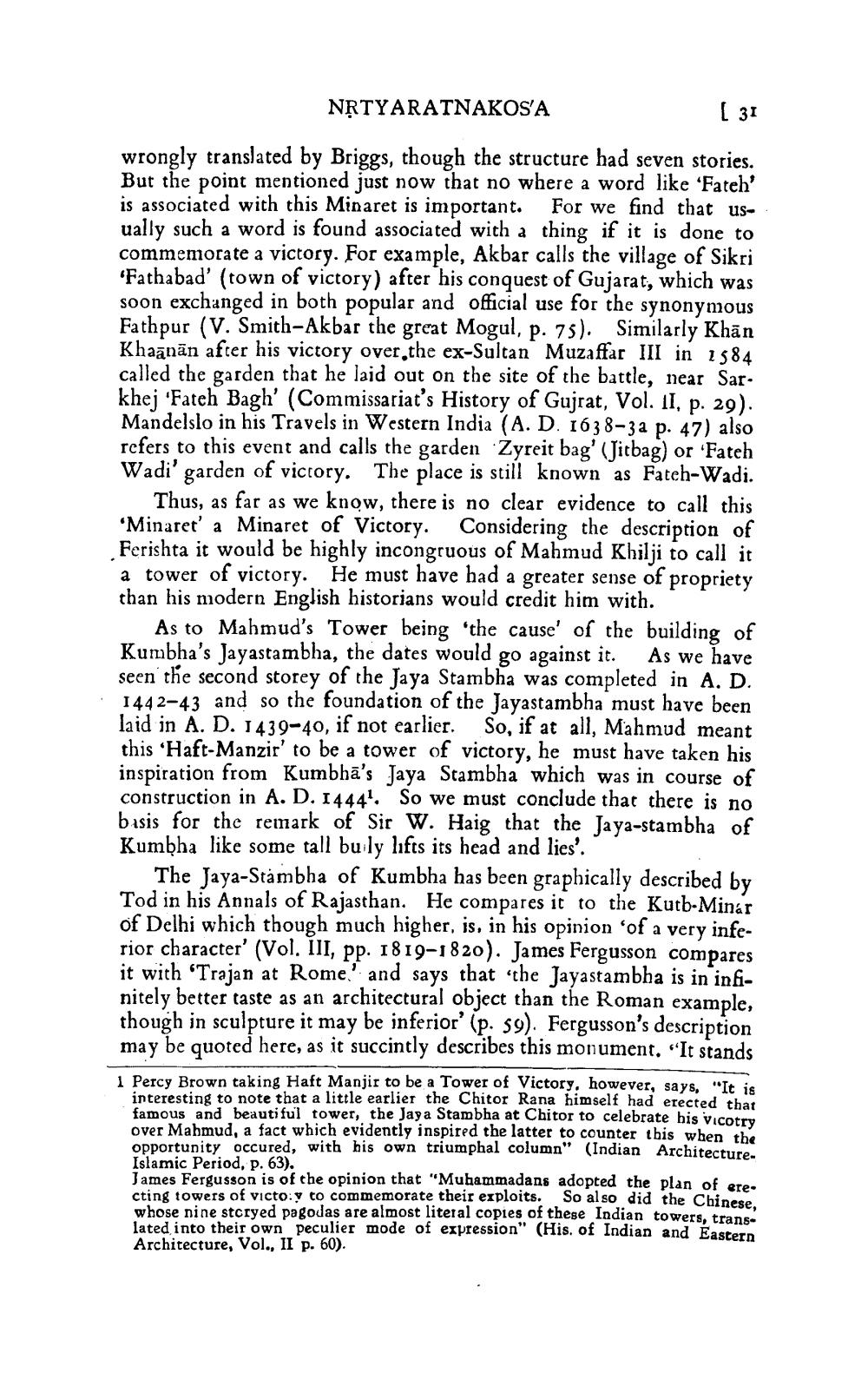________________
NRTYARATNAKOSA
[ 31
wrongly translated by Briggs, though the structure had seven stories. But the point mentioned just now that no where a word like 'Fateh' is associated with this Minaret is important. For we find that usually such a word is found associated with a thing if it is done to commemorate a victory. For example, Akbar calls the village of Sikri 'Fathabad' (town of victory) after his conquest of Gujarat, which was soon exchanged in both popular and official use for the synonymous Fathpur (V. Smith-Akbar the great Mogul, p. 75). Similarly Khăn Khaanān after his victory over the ex-Sultan Muzaffar III in 1584 called the garden that he laid out on the site of the battle, near Sar. khej 'Fateh Bagh' (Commissariat's History of Gujrat, Vol. II, p. 29). Mandelslo in his Travels in Western India (A. D. 1638–3 a p. 47) also refers to this event and calls the garden Zyreit bag' (Jitbag) or 'Fateh Wadi' garden of victory. The place is still known as Fateh-Wadi.
Thus, as far as we know, there is no clear evidence to call this ‘Minaret' a Minaret of Victory. Considering the description of Ferishta it would be highly incongruous of Mahmud Khilji to call it a tower of victory. He must have had a greater sense of propriety than his modern English historians would credit him with.
As to Mahmud's Tower being 'the cause of the building of Kumbha's Jayastambha, the dates would go against it. As we have seen the second storey of the Jaya Stambha was completed in A. D. 1442-43 and so the foundation of the Jayastambha must have been laid in A. D. 1410-40, if not earlier. So, if at all, Mahmud meant this ‘Haft-Manzir' to be a tower of victory, he must have taken his inspiration from Kumbhā's Jaya Stambha which was in course of construction in A. D. 1444. So we must conclude that there is no basis for the reinark of Sir W. Haig that the Jaya-stambha of Kumbha like some tall buily lifts its head and lies'.
The Jaya-Stambha of Kumbha has been graphically described by Tod in his Annals of Rajasthan. He compares it to the Kutb-Minár of Delhi which though much higher, is, in his opinion of a very inferior character' (Vol. III, pp. 1819-1820). James Fergusson compares it with 'Trajan at Rome.' and says that the Jayastambha is in infinitely better taste as an architectural object than the Roman example, though in sculpture it may be inferior' (p: 59). Fergusson's description may be quoted here, as it succintly describes this monument. "It stands
1 Percy Brown taking Haft Manjir to be a Tower of Victory. however, says, "It is interesting to note that a little earlier the Chitor Rana himself had erected that famous and beautiful tower, the Jaya Stambha at Chitor to celebrate bis Vicotry over Mahmud, a fact which evidently inspired the latter to counter this when the opportunity occured, with his own triumphal column" (Indian Architecture. Islamic Period, p. 63). James Fergusson is of the opinion that "Muhammadans adopted the plan of ere. cting towers of victo:y to commemorate their exploits. So also did the Chinese whose nine storyed pagodas are almost literal copies of these Indian towers, transe lated into their own peculier mode of expression" (His. of Indian and Eastern Architecture, Vol., II p. 60).




